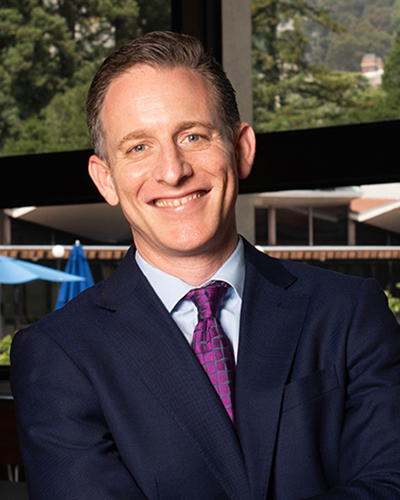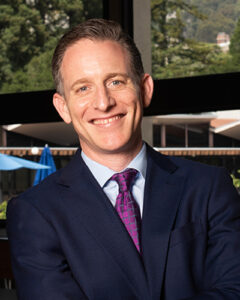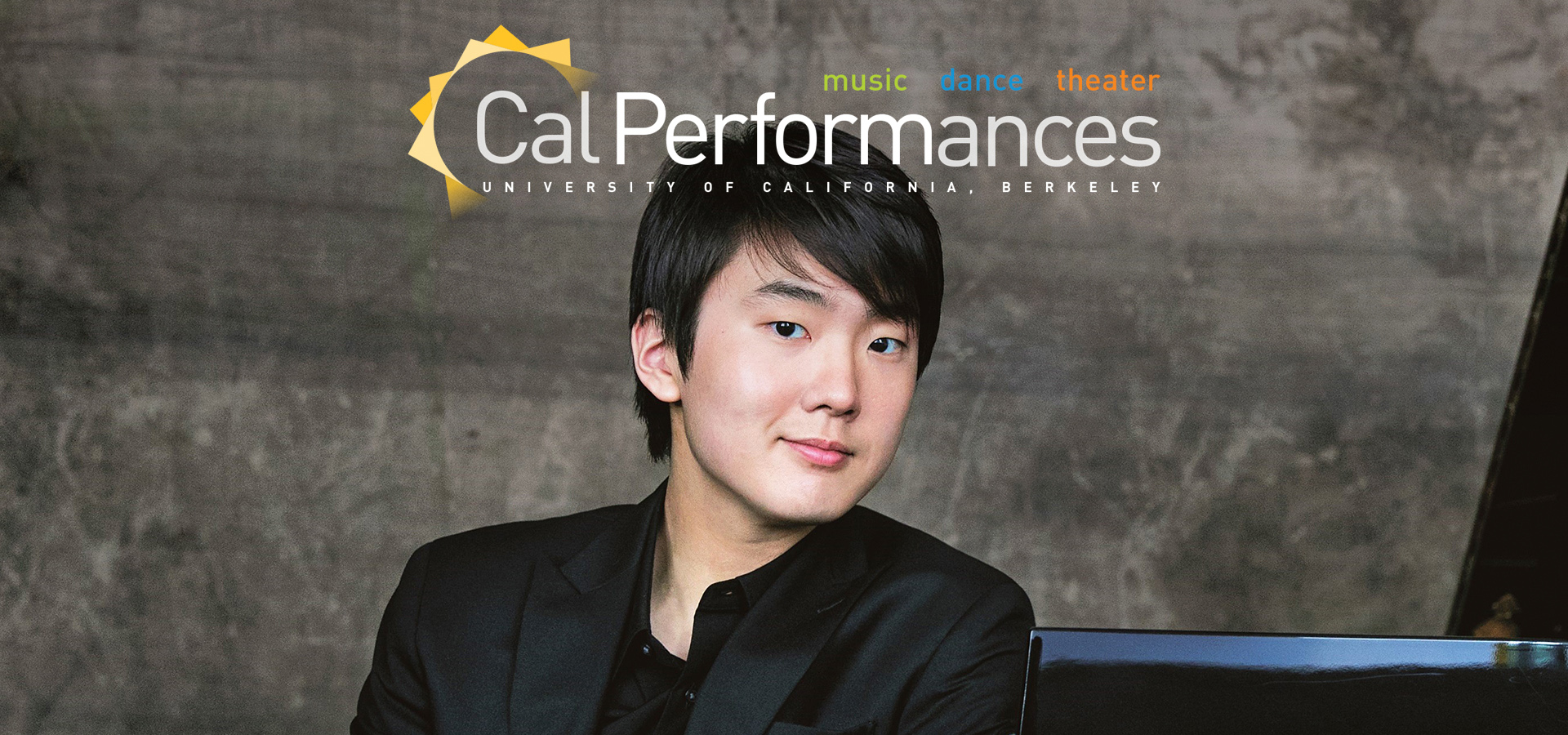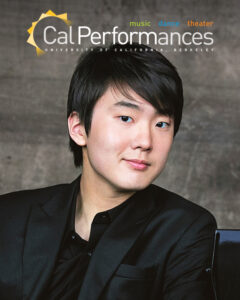Seong-Jin Cho, piano
Thursday, December 8, 2022, 7:30pm
Zellerbach Hall
Seong-Jin Cho records exclusively for Deutsche Grammophon
Support for Seong-Jin Cho is provided by Fred Levin, The Shenson Foundation.
Run time for this concert is approximately 1 hour and 50 minutes, including intermission, but not including any possible encores.
From the Executive and Artistic Director

Happy Holidays from Cal Performances! Like you, we enjoy celebrating these special times with those nearest and dearest to us. So, it’s particularly pleasing to welcome you to a December performance this year. As 2022 comes to a close, we’ll enjoy visits from one of our oldest and dearest friends, the renowned Takács Quartet in the first of two performances this season; the brilliant young pianist Seong-Jin Cho making his highly anticipated Cal Performances debut; and the red-hot dance company Camille A. Brown & Dancers, with its brilliant production of Brown’s ink. Whatever event(s) you’ve chosen to attend, thank you for spending part of your holiday season with us at UC Berkeley!
We’ll be back and up to speed in the new year with a host of brilliant programs! From January until May 2023—when we close our season with the Bay Area premiere of Octavia E. Butler’s powerful and prescient opera Parable of the Sower and a long-awaited recital with international dramatic soprano sensation Nina Stemme—we have a calendar packed with the very best in the live performing arts.
And what a schedule! Dozens of remarkable events, with highlights including the return of the legendary Vienna Philharmonic Orchestra under conductor Christian Thielemann (in his Bay Area debut); the beloved Mark Morris Dance Group in Morris’ new The Look of Love: An Evening of Dance to the Music of Burt Bacharach; the US premiere of revered South African artist William Kentridge’s astonishing new SIBYL (part of an exciting campus-wide residency with this singular artist); and a special concert with chamber music superstars pianist Emanuel Ax, violinist Leonidas Kavakos, and cellist Yo-Yo Ma. And these are only a few of the amazing performances that await you!
Upcoming Illuminations programming will continue to take advantage of Cal Performances’ unique positioning as a vital part of the world’s top-ranked public university. Over the coming months, we’ll be engaging communities on and off campus to examine the evolution of tools such as musical instruments and electronics, the complex relationships between the creators and users of technology, the possibilities enabled by technology’s impact on the creative process, and questions raised by the growing role of artificial intelligence in our society.
This concept of “Human and Machine” has never been so pertinent to so many. Particularly over the course of the pandemic, the rapid expansion of technology’s role in improving communication and in helping us emotionally process unforeseen and, at times, extraordinarily difficult events has made a permanent mark on our human history. Throughout time, our reliance on technology to communicate has—for better and worse—influenced how we understand others as well as ourselves. During this Illuminations season, we will investigate how technology has contributed to our capacity for self-expression, as well as the potential dangers it may pose.
Some programs this season will bring joy and delight, and others will inspire reflection and stir debate. We are committed to presenting this wide range of artistic expression on our stages because of our faith in the performing arts’ power to promote empathy. And it is because of our audiences’ openness and curiosity that we have the privilege of bringing such thought-provoking, adventurous performances to our campus. The Cal Performances community wants the arts to engage in important conversations, and to bring us all together as we see and feel the world through the experiences of others.
Please make sure to check out our brochures and our website for complete information about upcoming events. We can’t wait to share all the details with you, in print and online.
Again, Happy Holidays and Happy New Year!
Jeremy Geffen
Executive and Artistic Director, Cal Performances
 Happy Holidays from Cal Performances! Like you, we enjoy celebrating these special times with those nearest and dearest to us. So, it’s particularly pleasing to welcome you to a December performance this year. As 2022 comes to a close, we’ll enjoy visits from one of our oldest and dearest friends, the renowned Takács Quartet in the first of two performances this season; the brilliant young pianist Seong-Jin Cho making his highly anticipated Cal Performances debut; and the red-hot dance company Camille A. Brown & Dancers, with its brilliant production of Brown’s ink. Whatever event(s) you’ve chosen to attend, thank you for spending part of your holiday season with us at UC Berkeley!
Happy Holidays from Cal Performances! Like you, we enjoy celebrating these special times with those nearest and dearest to us. So, it’s particularly pleasing to welcome you to a December performance this year. As 2022 comes to a close, we’ll enjoy visits from one of our oldest and dearest friends, the renowned Takács Quartet in the first of two performances this season; the brilliant young pianist Seong-Jin Cho making his highly anticipated Cal Performances debut; and the red-hot dance company Camille A. Brown & Dancers, with its brilliant production of Brown’s ink. Whatever event(s) you’ve chosen to attend, thank you for spending part of your holiday season with us at UC Berkeley!
We’ll be back and up to speed in the new year with a host of brilliant programs! From January until May 2023—when we close our season with the Bay Area premiere of Octavia E. Butler’s powerful and prescient opera Parable of the Sower and a long-awaited recital with international dramatic soprano sensation Nina Stemme—we have a calendar packed with the very best in the live performing arts.
And what a schedule! Dozens of remarkable events, with highlights including the return of the legendary Vienna Philharmonic Orchestra under conductor Christian Thielemann (in his Bay Area debut); the beloved Mark Morris Dance Group in Morris’ new The Look of Love: An Evening of Dance to the Music of Burt Bacharach; the US premiere of revered South African artist William Kentridge’s astonishing new SIBYL (part of an exciting campus-wide residency with this singular artist); and a special concert with chamber music superstars pianist Emanuel Ax, violinist Leonidas Kavakos, and cellist Yo-Yo Ma. And these are only a few of the amazing performances that await you!
Upcoming Illuminations programming will continue to take advantage of Cal Performances’ unique positioning as a vital part of the world’s top-ranked public university. Over the coming months, we’ll be engaging communities on and off campus to examine the evolution of tools such as musical instruments and electronics, the complex relationships between the creators and users of technology, the possibilities enabled by technology’s impact on the creative process, and questions raised by the growing role of artificial intelligence in our society.
This concept of “Human and Machine” has never been so pertinent to so many. Particularly over the course of the pandemic, the rapid expansion of technology’s role in improving communication and in helping us emotionally process unforeseen and, at times, extraordinarily difficult events has made a permanent mark on our human history. Throughout time, our reliance on technology to communicate has—for better and worse—influenced how we understand others as well as ourselves. During this Illuminations season, we will investigate how technology has contributed to our capacity for self-expression, as well as the potential dangers it may pose.
Some programs this season will bring joy and delight, and others will inspire reflection and stir debate. We are committed to presenting this wide range of artistic expression on our stages because of our faith in the performing arts’ power to promote empathy. And it is because of our audiences’ openness and curiosity that we have the privilege of bringing such thought-provoking, adventurous performances to our campus. The Cal Performances community wants the arts to engage in important conversations, and to bring us all together as we see and feel the world through the experiences of others.
Please make sure to check out our brochures and our website for complete information about upcoming events. We can’t wait to share all the details with you, in print and online.
Again, Happy Holidays and Happy New Year!
Jeremy Geffen
Executive and Artistic Director, Cal Performances




